
San Diego International Airport, formerly known as Lindbergh Field, is an international airport three miles northwest of Downtown San Diego, California, United States. It is owned and operated by the San Diego County Regional Airport Authority. The airport covers 663 acres (268 ha) of land and is ranked the third busiest airport in California in terms of passenger traffic.
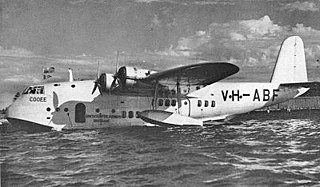
A flying boat is a type of fixed-winged seaplane with a hull, allowing it to land on water. It differs from a floatplane in having a fuselage that is purpose-designed for flotation, while floatplanes rely on fuselage-mounted floats for buoyancy.

A seaplane is a powered fixed-wing aircraft capable of taking off and landing (alighting) on water. Seaplanes are usually divided into two categories based on their technological characteristics: floatplanes and flying boats; the latter are generally far larger and can carry far more. Seaplanes that can also take off and land on airfields are in a subclass called amphibious aircraft, or amphibians. Seaplanes were sometimes called hydroplanes, but currently this term applies instead to motor-powered watercraft that use the technique of hydrodynamic lift to skim the surface of water when running at speed.

The Boeing 314 Clipper was an American long-range flying boat produced by Boeing from 1938 to 1941. One of the largest aircraft of its time, it had the range to cross the Atlantic and Pacific oceans. For its wing, Boeing re-used the design from the earlier XB-15 bomber prototype. Twelve Clippers were built, nine of which served with Pan Am.
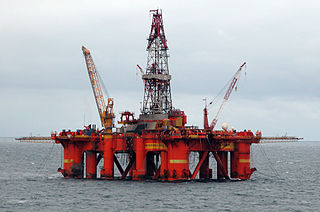
A semi-submersible platform is a specialised marine vessel used in offshore roles including as offshore drilling rigs, safety vessels, oil production platforms, and heavy lift cranes. They have good ship stability and seakeeping, better than drillships.

The first aerial circumnavigation of the world was completed in 1924 by four aviators from an eight-man team of the United States Army Air Service, the precursor of the United States Air Force. The 175-day journey covered over 26,345 miles (42,398 km). The team generally traveled east to west, around the northern-Pacific Rim, through to South Asia and Europe and back to the United States. Airmen Lowell H. Smith and Leslie P. Arnold, and Erik H. Nelson and John Harding Jr. made the trip in two single-engined open-cockpit Douglas World Cruisers (DWC) configured as floatplanes for most of the journey. Four more flyers in two additional DWC began the journey but their aircraft crashed or were forced down. All airmen survived.
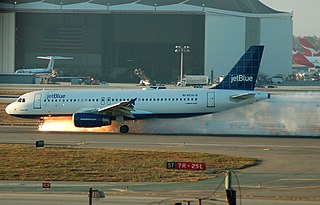
An emergency landing is a premature landing made by an aircraft in response to an emergency involving an imminent or ongoing threat to the safety and operation of the aircraft, or involving a sudden need for a passenger or crew on board to terminate the flight. It typically involves a forced diversion to the nearest or most suitable airport or airbase, or an off airport landing or ditching if the flight cannot reach an airfield. Flights under air traffic control will be given priority over all other aircraft operations upon the declaration of the emergency.
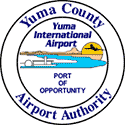
Yuma International Airport is a joint use airport with civilian and military flight activity operated in conjunction with the U.S. Marine Corps via the Marine Corps Air Station Yuma. The airfield is located 3.5 miles south of the central business district of Yuma, a city in Yuma County, Arizona, United States, and 150 miles east of San Diego International Airport. It is mostly used for military aviation, but is also served by one commercial airline and one aeromedical Medevac company as well as being used for general aviation activities.
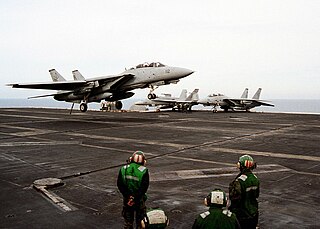
An arresting gear, or arrestor gear, is a mechanical system used to rapidly decelerate an aircraft as it lands. Arresting gear on aircraft carriers is an essential component of naval aviation, and it is most commonly used on CATOBAR and STOBAR aircraft carriers. Similar systems are also found at land-based airfields for expeditionary or emergency use. Typical systems consist of several steel wire ropes laid across the aircraft landing area, designed to be caught by an aircraft's tailhook. During a normal arrestment, the tailhook engages the wire and the aircraft's kinetic energy is transferred to hydraulic damping systems attached below the carrier deck. There are other related systems that use nets to catch aircraft wings or landing gear. These barricade and barrier systems are only used for emergency arrestments for aircraft without operable tailhooks.

In aviation, a water landing is, in the broadest sense, an aircraft landing on a body of water. Seaplanes, such as floatplanes and flying boats, land on water as a normal operation. Ditching is a controlled emergency landing on the water surface in an aircraft not designed for the purpose, a very rare occurrence. Controlled flight into the surface and uncontrolled flight ending in a body of water are generally not considered water landings or ditching.

Mobile offshore base (MOB), sometimes called a joint mobile offshore base (JMOB), is a concept for supporting military operations beyond the home shores, where conventional land bases are not available, by deploying on the high seas or in coastal waters, in-theater multipurpose floating base assembled from individual platforms. In essence, a MOB is a multipurpose modular self-propelled floating platform, or several interconnected platforms, that can perform multiple functions of a sea base including strike, deployment and logistics. An ocean-wise semi-submersible wave and wind resistant platform capable of moving at one-half the speed of conventional prepositioning monohull cargo ship has been researched and proposed, but never built.

Jenderal Ahmad Yani International Airport is an airport that serves the city of Semarang, in Central Java, Indonesia. The airport is named in honor of Ahmad Yani (1922–1965), who is a National Hero of Indonesia. As of 2018, it was one of the fastest-growing airports in the world by growth percentage. It became an international airport with the first flight of Garuda Indonesia to Singapore in August 2004. The airport is operated by PT Angkasa Pura I, a state enterprise of the Indonesian Ministry of Transport that manages airports in the eastern part of the country.

Very large floating structures (VLFSs) or very large floating platforms (VLFPs) are artificial islands, which may be constructed to create floating airports, bridges, breakwaters, piers and docks, storage facilities, wind and solar power plants, for military purposes, to create industrial space, emergency bases, entertainment facilities, recreation parks, mobile offshore structures and even for habitation. Currently, several different concepts have been proposed for building floating cities or huge living complexes. Some units have been constructed and are presently in operation.
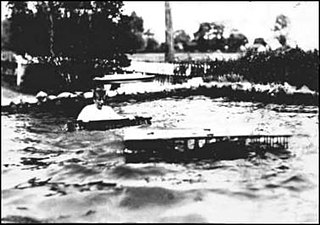
Edward Robert Armstrong (1876–1955) was a Canadian-American engineer and inventor who in 1927 proposed a series of "seadrome" floating airport platforms for airplanes to land on and refuel for transatlantic flights. While his original concept was made obsolete by long-range aircraft that did not need such refueling points, the idea of an anchored deep-sea platform was later applied to use for floating oil rigs.
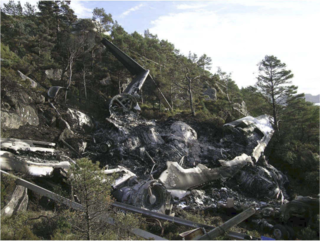
Atlantic Airways Flight 670 was a crash following a runway overrun of a British Aerospace 146-200A at 07:32 on 10 October 2006 at Stord Airport, Sørstokken, Norway. The aircraft's spoilers failed to deploy, causing inefficient braking. The Atlantic Airways aircraft fell down the steep cliff at the end of the runway at slow speed and burst into flames, killing four of sixteen people on board.
A Pneumatic stabilized platform (PSP) is a technology used to float a very large floating structure (VLFS).
Donald Alywn Innis,, is an American architect based in San Diego, California. Innis is also an inventor and engineer and has pioneered the idea of floating real estate, specifically the notion of a floating airport using pneumatic stabilized platform (PSP) technology which he has developed and patented through his company, Float Incorporated. Innis designed several notable San Diego landmarks, including the 1970s remodeling of the San Diego Broadway Pier, the master plan for the San Diego Embarcadero, and Terminal One of the San Diego International airport. He is a long-standing member of the American Institute of Architects.

Floats are airtight hollow structures, similar to pressure vessels, designed to provide buoyancy in water. Their principal applications are in watercraft hulls, aircraft floats, floating pier, pontoon rhinos, pontoon causeways, and marine engineering applications such as salvage.

Ocean colonization is the theory of extending society territorially to the ocean by permanent settlements floating on the ocean surface and submerged below, employing offshore construction. In a broader sense the ocean being subject of colonization and colonialism has been critically identified with exploitive ocean development, such as deep sea mining. In this regard blue justice groups have also used the term blue colonization.

R. Cengiz Ertekin is a professor of Marine Hydrodynamics and Ocean Engineering. He currently holds a guest professor position at Harbin Engineering University of China. He is best known for his contributions to the development of nonlinear water wave theories, hydroelasticity of very large floating structures (VLFS), wave energy, and tsunami and storm impact on coastal bridges. He is also the co-developer, along with Professor H. Ronald Riggs of the University of Hawaiʻi, of the computer program HYDRAN for solving linear fluid-structure interaction problems of floating and fixed bodies.



















